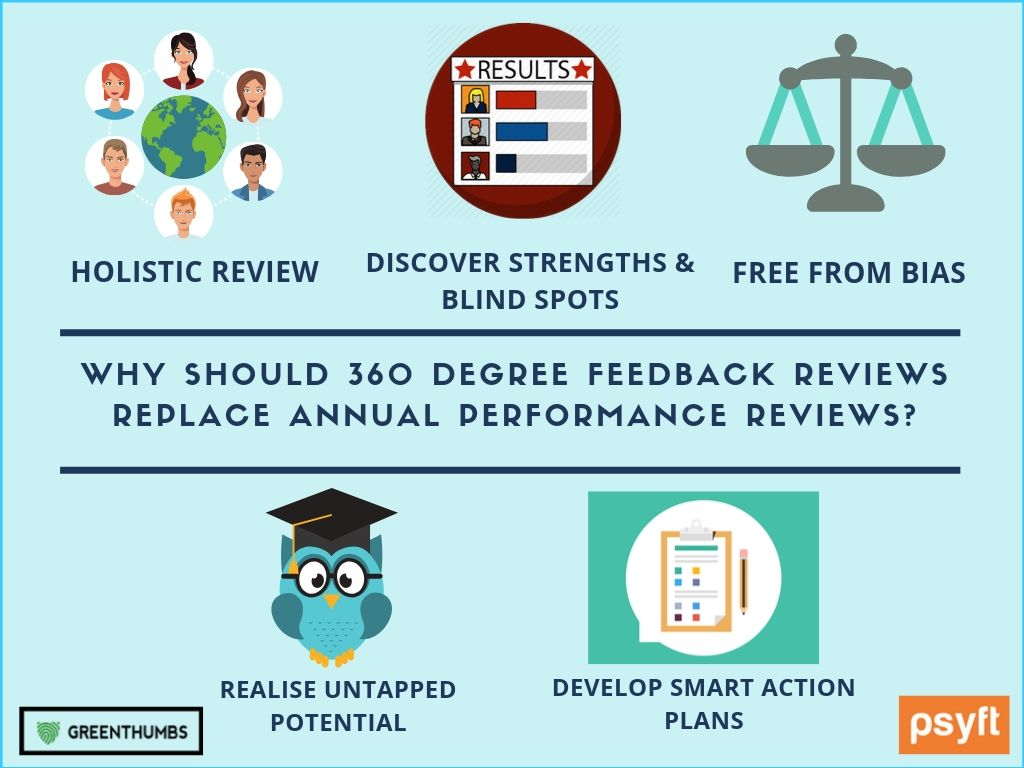Blogs
Your source to the latest insights on what's trending in the HR arena - Recruitment, Talent Assessments, Employee Surveys and Training.

Why should a 360 Degree Feedback Review Replace Annual Performance Reviews?
360 Degree Feedback reviews can prove to be more effective, competent, easy and quick alternative to annual performance appraisals that are run in many organisations.
Importance of Performance Appraisals Performance management is crucial for every organization. What’s important to realise is the fact that these appraisals should not only be based on few KPIs, or be based on some numerical performance scores. Performance reviews should focus on the softer/intangible aspects as well. The aim should be to work towards enhancing and developing employees performance by optimum levels. To make performance appraisals productive and successful, organisations must focus on reviewing employee performance in an unbiased manner (free from favouritism). Managers should create a balance between providing an honest feedback for their employees and guiding them towards further improvement. This will help ensure that an organization is on course to achieve its business objectives accompanied with maximum employee productivity.
Employee Reviews help to foster meaningful employer- employee relationship Know your employees, thoie work behaviours etc. helps to strengthen and simplify the many a times complex relationship between bosses and their employees. This leads to a sense of comfort which helps to ensure that feedback is taken constructively and in the right spirit.
Employee Reviews show that the organisation cares for its employees Reviews where employees are also to express their opinions are the best. When you ask your employees for feedback, it generates a feeling of belonging ness among them. They feel more connected and engaged with their company. Feedback helps employees become the best version of themselves and also levels of improves employee engagement.
Traditional Approaches to obtaining feedback running appraisals
The most common approaches used to run performance appraisals are:
Rating Scales: Rating scales are numerical scales prepared to represent the job performance criteria - ranging from excellent to poor. Each employee is rated as per relevant criteria and a consolidated score is calculated. Checklist: Under checklists employees are simply marked for a binary “Yes” or “No” against all relevant job metric. Then, the most relevant criteria are prioritized with “Yes” being a preferred alternative. Cost Accounting Method: Under cost accounting method employee performance is measured in monetary terms, i.e. cost that incurred by the company on retention in vis-s-vis the contribution made by an employee. Comparative Evaluation Approach: Comparative analysis are done, wherein the performance of one employee is compared with the performance of another co-worker, and a rating is determined.
All these appraisal methods lack in keeping up with the dynamic nature of a workplace that exists today.
Why is the 360 Degree Review better than an Annual Review? Industry experts from across the world recommend scrapping the Annual Performance reviews. Not only has the annual review become outdated but is also a cost and time-consuming and cumbersome process. It’s time to move towards a performance appraisal system that drives employee performance along with employee engagement levels.
Companies that focus on development of their employees have already begun to use the 360 Degree Feedback. 360 degree appraisal is increasingly becoming a useful appraisal tool for the cost competitiveness and efficiency it brings along. It benefits organizations in ways such as:
- analyse and evaluate employees performance in an holistic manner.
- leverage upon the untapped potential of their employees.
- A comprehensive assessment of employee performance – Unlike the case in traditional methods, where only one person is in-charge for the appraisal process; in a 360 degree feedback review, an individual receives feedback from across the organisational hierarchy and also external stakeholders (customers, vendors, etc) thereby providing a holistic performance.
- An Unbiased Review - 360 Degree Feedbacks are generally run keeping the Reponses confidential and anonymous. This eliminates the possibility of a personal bias and at the same time makes the entire appraisal becomes more inclusive. In traditional methods, the feedback process becomes more of an interrogation, hampering not just development but also relationships. 360 Degree Feedbacks promote discussion over one-way interviews. This facilitates the switch from passive to reflective listening.
- Helps identify blind spots & hidden strengths: 360 degree feedback is a more effective method to summarize feedback and identify hidden strengths that can be leveraged upon as well as blind spots that need for which specific actions need to be taken.
Read: 7 Steps to making 360 degree appraisals a success
A 360 Degree Feedback offers an efficient and credible system for assessing employees and at the same time helping them grow.
360 Degree Feedback is an effective tool for employee development, especially when conducted on a regular basis. 360 degree feedback surveys help organisations meet their short and long-term business goals. When run in the right manner, 360 degree evaluations can help organizations build a productive and motivated workforce. It’s all about being able to bring together the employee review system and the L&D programs for employees.
The primary vision behind choosing a 360-degree feedback approach is to make ‘action-planning’ easier for both the employers and their employees, ensuring promising business outcome for an organisation.
FAQs
1 : What is the significance of performance appraisals in organizations?
Answer : Performance management is vital for organizations, emphasizing the need for comprehensive assessments that go beyond numerical scores. Appraisals should focus on intangible aspects, fostering employee development and aligning with business objectives.
2 : How do employee reviews contribute to fostering a meaningful employer-employee relationship?
Answer : Employee reviews provide insights into work behaviors, strengthening the often-complex relationship between bosses and employees. Understanding employees promotes constructive feedback acceptance, creating a comfortable environment for mutual growth.
3 : What are the drawbacks of traditional approaches to obtaining feedback through appraisals?
Answer : Common appraisal methods like rating scales, checklists, cost accounting, and comparative evaluations fall short in adapting to the dynamic nature of today's workplace. These methods lack the inclusivity and holistic feedback provided by 360-degree reviews.
4 : Why is the 360 Degree Review considered superior to the Annual Review?
Answer : Industry experts advocate replacing Annual Performance Reviews due to their outdated, time-consuming, and costly nature. The 360 Degree Feedback offers a more efficient appraisal system, providing a holistic assessment, unbiased reviews, and facilitating employee development.
5 : How does the 360 Degree Feedback contribute to employee development?
Answer : The 360 Degree Feedback is an effective tool for assessing employees holistically, identifying hidden strengths and blind spots. This method promotes discussion, reflective listening, and action planning, making it easier for employers and employees to achieve promising business outcomes.
Recent Articles
News Center


- India Today - 7 reasons companies ask for psychometric tests
- Business World - AI - The New Secret Sauce in Psychometric Assessments
- DNA - HR Trends for 2018
- The Hindu - Psychometric Assessment a "game changer" in hiring
- Entrepreneur - 9 ways to promote actionable feedback at organisations
- Human Capital - Looking Beyond Performance Appraisals
Top Trending Pages
- Best Employee Engagement Survey Company
- Executive Search | Online Assessments & Surveys
- Top Personality Assessment Providers in India
- Talent Search | HR Consulting | Recruitment
- Manager Effectiveness Survey
- What is Training Needs Analysis (TNA)? - Meaning & Benefits
- GreenThumbs: One of the Best Executive Search Firms in India
- Know Your Employee Net Promoter Score
- Employee Onboarding Survey
- 360 Degree Feedback | FAQs
